Racial influences

We have essentially sets that exist across all races; and each race that dons those armor sets is going to have their own racial influence on the presentation of those particular sets. So that's something that's unique in how each of the races get diversified. Additionally, the more that one particular race contributes to a node's development, it's going to manifest in that particular node's architectural influences. You're going to see the architectures of those races become manifest within the nodes as well: That's another way that we diversify each race and we present each race's culture in the game as through those architectures, through those props that exist, through the tailoring of the armor sets that the NPC might wear, to the different factions that exist. Factions will have their own affiliation with different races as well. Each race will also have some different nomenclature when it comes to the lore, or comes to locations in the world. They're going to have their own language influences as well: The way they speak is something that's going to be distinct between races; when you have dialogue trees with particular NPCs. So all of those things really go into setting an immersive world where the cultures have their own identity.[2] – Steven Sharif
Cultural influences manifest in many ways, from node and gear aesthetics to NPC languages and lore.[2][3][4]
- Gear appearance of certain armor sets is influenced by the player's race.[2]
- Node layout and style is influenced by the race that contributes the most to that node.[2]
- There is an attrition and that attrition on experience and influence is heightened based on the performance of the race in the world. So if all these nodes are Orc nodes then their attrition rate is very high to compete with the cultural establishment of new nodes because they have more influence in the world and a popular opinion is against them in their outlying regions that they do not have influence in.[5] – Steven Sharif
Artistic influences
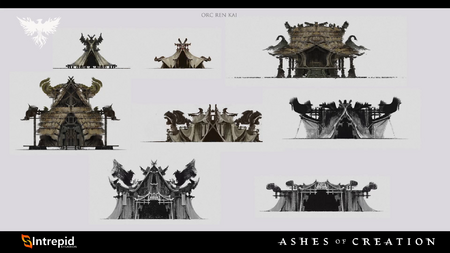
Character races are super important. These are the choices that we make at the onset of our adventure in an MMORPG: what race- not just mechanically aligns with our decisions, if those races have game mechanics behind them from a stat perspective, but visually and culturally and historically: What are these? What do these races represent? So it's important that visually they're distinct. And everyone's seen fantasy games do Elves, so everyone's seen them do Humans, everyone's seen them do Orcs: There's an established expectation almost behind what these traditional fantasy races represent; and there's a risk, because whenever you're creating a new IP or a new story or a new world- a new Universe; a realm in which things don't have to always be the norm, you can take a little bit of creative liberty to redefine some of the aspects of a particular race; and that can be a good thing, because it's something that is new to players. It's something that is unique to the realm that we're building- the surroundings that you have. So what we wanted to do was push a little bit more on the unique side of what the Py'rai would look like from a visual perspective.[7] – Steven Sharif
- Aelean architecture has a French medieval influence.[8]
- Dünir have a Nordic cultural influence.[9]
- Empyreans have a Greco-Roman imperialistic feeling.[10]
- The Kaelar have a European influence.[11]
- The Niküa have a Polynesian influence.[12][10]
- The Py'Rai have a Navajo Native American influence.[10] Py'Rai architecture has a woodland inspiration.[13][14]
- Pyrian architecture has a Greco-Roman influence.[15]
- Ren'Kai architecture has an Asian influence.[6]
- The Vaelune have a Middle Eastern influence.[16]
- The Vek have a Mesoamerican influence.[16]
- You will see in the different races that are available from a player character standpoint a lot of different influences that reflect many cultures in the world: Not just European, not just Africa, not Mesoamerican. These cultures are going to be present in many of the races.[17] – Steven Sharif
- The idea is just to find a base component in the real world as a starting point and then to begin to fantasize.[8] – Steven Sharif
Racial weapons and armor

Violet light and myself are wearing exactly the same armor set right: Same stats, same everything, but it drops for her it looks one way, it drops for me it looks another way; and... a small part of that is gender, but then the other part of it is race. So because I was a Vaelune in that playthrough my armor was in the Vaelune style; and when she picked it up it was in the elven style because she was an elf. So that gives you an example of sort of the breadth of looks that we're going for and how we try to capture like who you are as as a character and allow you to build your look that way.[19] – Jeffrey Bard
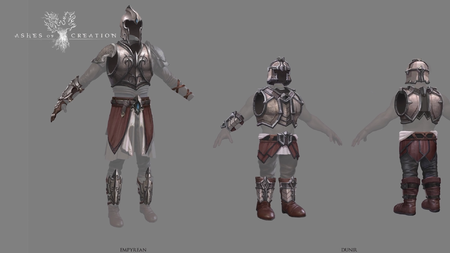
We have essentially sets that exist across all races; and each race that dons those armor sets is going to have their own racial influence on the presentation of those particular sets. So that's something that's unique in how each of the races get diversified.[2] – Steven Sharif
Weapons and armor are not race locked, but armor will take on a racial appearance.[2][21][22]
- The customization of equipment per race is really focused on Armor sets not Weapon props. Weapon props will, from a model standpoint, will translate pretty one-to-one across the races.[23] – Steven Sharif
- Racial appearance of gear is focused on Armor. Weapons will not change in appearance but will scale in size based on race.[24][23]
- Let's say for example you have the Eagle set or something, right: The Eagle set has in art, it has a thematic design that's going to include certain attachments to the armor. It's going to include color palette and theme. It's going to have some aspects to it that define it as the Eagle set, right. When a Elf wears the Eagle set or when an Orc wears the Eagle set, you obviously have two different cultures there; and you don't want to stomp out that culture by assigning a de facto 'This is the Eagle set and this is how it looks on everybody.' What we want to have is cultural influences play a role in showing how that set looks.[23] – Steven Sharif
- Racial appearance of gear sets is tied to the character model of that race.[25]
- When you say, what if I'm an Orc but want to look like an Elf and I want my Eagle set to be the Elf representation? Well the issue becomes there that Orcs have a different organic model. You know, their body is different than that of the Elf. So, from a scope-creep standpoint, it's one thing to add different influences that represent the cultures that are donning the armor; it's another thing to adapt each influence as a matrix that can be worn pretty much by everything. From a scope perspective, that's a very difficult task for the character artists to tackle. So instead what we've done is, in order to facilitate a variety of cultural representation between the races but allow for the sharing of assets like different armor sets, we give different representations of those armor sets to each race.[25] – Steven Sharif
- Q: Since a single armor set will look different on each race, how will we have large varieties of in-game achievable gear for each race if we have to make nine different looks for each set?
- A: The approach for that is to create a modular piece set for armor creation; and the way we achieve that is by two steps: So, on the modeling side, each race has these geo sets basically where you're creating pieces of the armor for heavy plate armor, for medium, for robes; and you get to grab those modular pieces and mix and match as design makes a request for a particular set to the art teams. So, design comes along and they say, "hey we have a theme for a set that we want to create", so let's use Carphin in that example; and that theme from design's standpoint is going to include color, it's going to include materials, it's going to have an etymology for the set to give a background so that they can incorporate certain types of attachments- whatever they want to include on the art side. Then, the character team says, "okay let's take our base sets of geo and let's mix and match those pieces to create the Carphin set and then we're going to do a materials pass on it, and then we're going to do a color pass on it"; and that way we have a lot of essentially pieces of the puzzle to create these many different unique sets. Now we can also deform pieces across from race to race. So, even if we create unique geo on a per-race basis, we can grab the pauldron from the Human set and put it onto the Vek representation; and the end game there is that we have a particular set, for example Carphin, and that Carphin is communicating the theme; and when you don the armor for the Carphin set- you've acquired the Carphin set and you put it on- it is going to look Vek if you're a Vek. It is going to look Kaelar if you're a Kaelar, but it is still going to have the identity and the theme of the Carphin set.[26] – Steven Sharif
Node layout and style
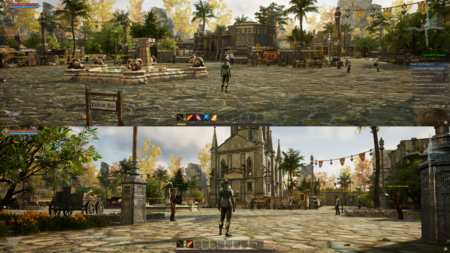
The layout and architecture within a Node’s development area are determined by influential race. For example, a stage 3 Node with the majority of player contribution being Py'rai would have a Py'rai village with Py'rai architecture. Most NPCs would be Py'rai elves, and offer questlines within the Py'rai narrative.[27] – Margaret Krohn
Each player’s contributed experience is flagged with their character race and other identifiers. When a Node advances, the race with the highest experience contribution determines the Node’s style and culture. This style and culture change can happen at every Node Stage. For example, if a Node advances to Level 2 - Encampment Stage and 51% of all experience was earned by Ren’Kai players, the Node will be a Level 2 Ren’Kai Node. If that same Node advances to a Level 3 - Village Stage Node, but the Py'Rai contributed 62% of all the experience earned, then the Node will be a Level 3 Py'Rai Node.[4] – Margaret Krohn
Node layout and style is determined by several factors:[28][29]
- The way that the node system is built is that they can exist across a spread of 18 biomes, but at the same time have to represent the cultural influence of these cultures that are intrinsically a part of a specific biome.[30] – Steven Sharif
- Environment (biome) and location of the node.[30][28][29]
- Nodes will adjust the local topography to fit the aesthetic and mechanical requirements of the node.[31]
- Currently the way that the platform system is set up, is it's capable of adjusting the topography of the node's footprint, regardless of the surrounding terrain. So the reason for that is we want to have flexibility in the presentation of the node's layout and how it is essentially both from an aesthetic standpoint as well as a mechanical standpoint with node sieges- how it's constructed and that construction should have the ability to take on a variance of different types of topography. So it shouldn't be dependent on the surrounding area. Now that's not to say that the surrounding area isn't going to have some influence over. So for example... we're experimenting a little bit with the platform tech and putting up a node up against the side of a mountain or on the edge of a cliff or something that has a beautiful vista. Those are things that we're going to test out obviously as we continue to work on the node tool and how that platform system works, but the idea is to have the node independent of the surrounding terrain.[31] – Steven Sharif
- Some parts are determined by the area it's in. Some parts are determined by the type it is. Some parts are determined by the race it is; and then the rest of it is determined by the mayor.[29] – Jeffrey Bard
- Race that contributed the highest percentage to the node's advancement will alter the racial appearance of its buildings, NPCs, and props.[2][32][28][4][29][33][34]
- All nodes, whether they're associated with a castle or associated with normal node structure, has cultural influences that replicate over to the buildings that are produced and the NPCs that are present.[36] – Steven Sharif
- The rest is determined by the node's mayor.[29]
- It should be possible for a node to complete several building projects within a mayor's one month term in office.[37]
- Q: How long would you say it will take players on average to fill/build up a node completely from wilderness to metropolis?
- A: It's one thing to get a node to a certain level: it's another thing to develop the node; and I can't really give you an on-average expectation, because there's a lot of variables at play. There's how many citizens does the node have attracted to it; what's the type of traffic that the node is attracting to it based on things like its tax rates, or the specialization that it chose to spec into, based on the building types it's chosen to build. All of those things are variables that can affect the quote-unquote "average build-out time" of a particular node. So it's difficult to give you an average when there's so many variables along those lines. But the idea is that if there is a particular project that players are interested in in developing based on the node stage, that they would have the ability to complete several of those projects as within a single term of a mayor; and a term of a mayor is one month.[37] – Steven Sharif
NPC racial interaction
- NPCs will react differently to different character races.[38]
- Languages will be distinct between NPC races and in the lore.[2]
- Certain quest givers and NPCs may only be present at nodes with certain cultural influences.[39]
- Depending on the cultural influence of the node activates certain types of quest lines and/or sponsors. Some of those are shared, some of those are general. Some of those relate to a progression path that is a first time user experience. Those will be constant across all culture types. Some of them, however, are predicates that spawn when certain story arcs and/or events, or commissions or buy orders become present within the node; and those might change based on the cultural influence of the node. So there is a separation between those populations.[39] – Steven Sharif
NPC languages
The race of a NPC influences its language and nomenclature in terms of its dialogue tree.[2]
Storyline quests
Story arc quests (Storyline quests/Narrative quests) contain objectives for each chapter of a story arc.[40][41][42][43][44][45]
- Players can progress each chapter by completing story arc quests within the timeframe that each chapter is active.[42]
- Story arcs can branch into different stories with multiple possible endings depending on the quest objectives that players complete during each chapter.[40][41][43]
- You can't really farm the quests in any meaningful way, because once you've done the quests in a chapter, that's it until the next chapter. Whether 1000 people participate or 10, the chapters will stay active for the same length of time, and as long as you participate in the clearly-marked time frame in your quest journal, you're good. The only thing that a concentrated effort can help with is influencing the narrative paths through the arcs.[46] – Skott B
- These quests stages can be failed. The ability to retry a failed quest depends on Node progression.[43]
- There will be many different quests that actually have stages of the storyline; and these stages can actually be failed. You can actually fail a storyline; which sucks when you think about it, but at the same time that risk makes your investment that much more important.[43] – Steven Sharif
- Quests may differ based on the stages of nearby nodes, seasonal influences, and events such as world bosses.[47]
- Quests involving citizens from multiple nodes are unlocked based on the alliances and other relationships between the nodes and their progression.[48]
Calendar events
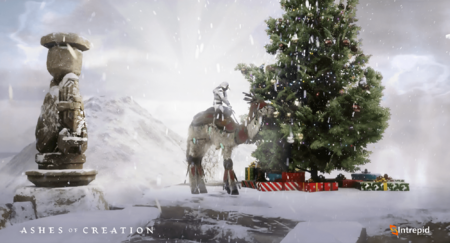
Calendar Events can be seen as holiday-related celebrations or other seasonal content. Imagine these Events as things you may experience annually, based on the cultures within the world. Some of these may derive from the seasons, and how the nodes in those areas are affected by them. These will most often be server-wide and provide unique content for a specific duration of time during the calendar year.[49]
Calendar events (seasonal events/holidays) in Ashes of Creation can be in-game events or they can relate to the real-world in some way.[50][51][52]
- Events are not a direct parallel with real world events. Instead, there will be in-game lore behind seasonal events that can relate to the real-world in some way.[50][51][52]
- Certain calendar events will incorporate the cultural identity of the various character races.[53]
- Part of the things that they're working on is creating a lot of cultural identity for these character races and how we can bring about these calendar events from the perspective of each individual race. That's something that I think is going to be really helping identify or giving identity to each of the character races.[53] – Steven Sharif
- Seasonal events in-game may not exactly align with real-world seasons due to the different in-game seasonal cycle.[54]
- Will seasonal events in the real-world align with the seasonal rotation in the game world? And I think in that sense probably not. That's going to require a little bit of suspension of disbelief in understanding that. But it's also fair that in-game events do not need to be perfectly cyclical like let's say seasonal events are in the real world. They could have a non-uniform cycle associated with them... There is something to be said for having that represented in the game as long as it's immersive; as long as it's contextualized within the story and the world and the universe that we've created; and isn't a direct homage to Santa Claus in the real-world, just to use a prime example of something.[54] – Steven Sharif
- Holiday events are not going be "campy" or immersion-breaking.[50]
- We have a lot of ideas on how certain real-world holidays can be contextualized within the game world and seem fitting.[50] – Steven Sharif
Events may bring seasonal change.[35][55]
- A raid boss, such as a winter dragon, may appear because a node has developed to Town (stage 4). This may bring an eternal winter that affects crop rotations until it is killed.[35][55]
See also
References
- ↑ Livestream, June 26, 2020 (45:32).
- ↑ 2.0 2.1 2.2 2.3 2.4 2.5 2.6 2.7 2.8 Livestream, March 31, 2022 (4:57).
- ↑ 3.0 3.1 Interview, February 7, 2021 (33:00).
- ↑ 4.0 4.1 4.2 4.3 Blog - Know Your Nodes - Advance and Destroy.
- ↑ 5.0 5.1 Interview, May 11, 2018 (1:00:19).
- ↑ 6.0 6.1 Livestream, October 31, 2019 (40:27).
- ↑ Livestream, February 25, 2022 (49:42).
- ↑ 8.0 8.1 Interview, October 20, 2018 (3:47:17).
- ↑

- ↑ 10.0 10.1 10.2 Interview, May 11, 2018 (1:03:21).
- ↑ Podcast, May 11, 2018 (31:35).
- ↑ Livestream, September 30, 2022 (1:08:24).
- ↑ Livestream, February 25, 2022 (44:28).
- ↑

- ↑ Livestream, October 16, 2017 (15:58).
- ↑ 16.0 16.1 Podcast, May 11, 2018 (31:35).
- ↑ Interview, May 11, 2018 (1:04:27).
- ↑ Video, September 30, 2020 (2:44).
- ↑ Livestream, September 30, 2020 (47:47).
- ↑ Livestream, July 26, 2019 (54:06).
- ↑ Livestream, May 26, 2017 (44:11).
- ↑ Livestream, May 26, 2017 (20:46).
- ↑ 23.0 23.1 23.2 Podcast, August 4, 2018 (53:43).
- ↑ Livestream, October 28, 2022 (1:41:06).
- ↑ 25.0 25.1 Podcast, August 4, 2018 (55:17).
- ↑ Livestream, February 29, 2024 (1:15:51).
- ↑ Blog - Know Your Nodes - The Basics.
- ↑ 28.0 28.1 28.2 Livestream, October 30, 2020 (39:17).
- ↑ 29.0 29.1 29.2 29.3 29.4 29.5 Livestream, September 27, 2018 (53:06).
- ↑ 30.0 30.1 Livestream, February 25, 2022 (41:00).
- ↑ 31.0 31.1 Livestream, February 26, 2021 (1:12:18).
- ↑ Podcast, April 11, 2021 (29:47).
- ↑ Interview, May 11, 2018 (54:34).
- ↑ Livestream, May 26, 2017 (21:23).
- ↑ 35.0 35.1 35.2 Podcast, April 11, 2021 (23:36).
- ↑ 36.0 36.1 Interview, May 11, 2018 (47:27).
- ↑ 37.0 37.1 Livestream, July 29, 2022 (1:13:09).
- ↑ 38.0 38.1 Podcast, April 23, 2018 (29:56).
- ↑ 39.0 39.1 Interview, July 9, 2023 (1:35:28).
- ↑ 40.0 40.1 Livestream, April 7, 2023 (58:39).
- ↑ 41.0 41.1 41.2 Video, March 31, 2023 (14:20).
- ↑ 42.0 42.1 Video, March 31, 2023 (12:47).
- ↑ 43.0 43.1 43.2 43.3 Interview, October 20, 2018 (2:36:25).
- ↑ Livestream, January 18, 2018 (39:08).
- ↑ MMOGames interview, January 2017
- ↑ 46.0 46.1
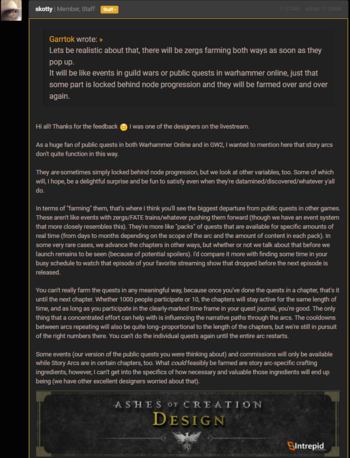
- ↑ Livestream, March 26, 2021 (1:12:51).
- ↑ Livestream, July 25, 2020 (1:50:20).
- ↑ Types of Events on Verra.
- ↑ 50.0 50.1 50.2 50.3 Livestream, April 29, 2022 (36:51).
- ↑ 51.0 51.1 Interview, October 20, 2018 (7:31).
- ↑ 52.0 52.1 Livestream, May 10, 2017 (40:36).
- ↑ 53.0 53.1 Livestream, April 29, 2022 (38:05).
- ↑ 54.0 54.1 Livestream, April 29, 2022 (50:49).
- ↑ 55.0 55.1 Livestream, May 8, 2017 (20:27).